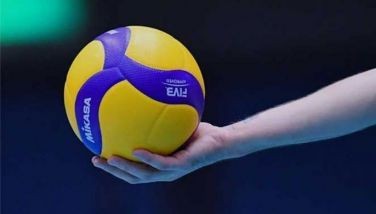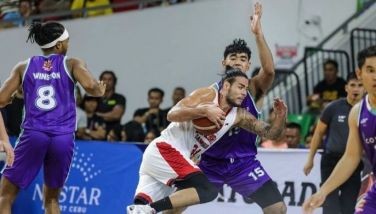Wheelchair coach inspires Pinoys

SYDNEY – The man who coached Australia to the wheelchair basketball gold medal at the 2008 Summer Paralympics in Beijing was an inspiring speaker at the opening session of the five-day development program exclusively arranged by Basketball New South Wales (BNSW) and New South Wales Institute of Sport (NSWIS) for visiting La Salle head coach Juno Sauler and assistant coaches Allan Caidic and Jun Limpot.
Ben Ettridge, whose father Len was a Paralympian, spoke to the La Salle coaches Monday afternoon, a few hours after the guests arrived on a PAL flight from Manila. He explained what it’s like coaching a team of disabled or physically-challenged, wheelchair-bound players. Sauler was so moved by Ettridge’s story-telling that after consulting with Caidic and Limpot, said he would find ways for the La Salle players to be more aware of their social responsibilities as high-profile athletes.
Ettridge said it’s a privilege to work with the wheelchair team. “It doesn’t take much to motivate the players,†he said. “They’re actually inspiring me more than I’m inspiring them. They’re survivors of car wrecks, cancer, some were crushed under vehicles. But they go out there to compete, they want to be elite performers with an elite mentality. My job is to make them faster, stronger and bigger, to make them shoot and play better. All over the country, we’ve got a pool of 36 players. When we start forming our national team, we trim the cast to 18 then finally, 12. In 2003, our national wheelchair team had players up to 40. Today, the average age is 27. We don’t pay players to play, they train five days a week, lift thrice a week, and they sacrifice their time and effort for the country. We use a national depth chart to line up players for the future. If you’re a veteran, there’s pressure from underneath to continue to play at a high level, that’s motivation enough to get you going because you don’t want to be dislodged.â€
The wheelchair game is essentially the same as in a regular contest. “There’s a three-second rule, we cross the line within eight seconds, we have 24 seconds to shoot,†said Ettridge. “But in the wheelchair game, we’re allowed to dribble the ball with two hands and they’ve waived the double dribble rule. Players are classified from the worst disability to the least using a point system where 1.0 is most disabled then 2.0, 3.0, 4.0 and 4.5 for least disabled. Any five players on the floor must add up to 14 rating points. The ratings are based on degree of functionality. The worst case involved disability from the chest down. In leagues in Spain, Italy and Germany, there is a crossover classification of 5.0 where an abled player agrees to be strapped to a wheelchair while playing.â€
* * * *
Ettridge said at practice, players are deliberately toppled from their wheelchairs to test their ability to straighten up on their own. “Our team is called the Rollers and we’re always moving around,†he said. “Every Easter, we play eight to 10 games in Europe. Then once in two years, we tour the US and Canada. Like in any team, I want the Rollers to shoot 50 percent from the floor, lay up with the left or right, hit 75 percent from the line, 35 percent from three-point distance and hold opponents to 13 or 14 or 15 in a quarter. Next week, we play in Japan then Thailand on the way to the World Championships in Goyang City, South Korea, in July.â€
Ettridge, who became the Australian national wheelchair team coach in 2007, said the Rollers play a cerebral style to compensate for their disability. “We do pick-and-rolls,†he said. “We do shooting practice. We’ve got players with birth defects, scars from motor vehicle or motorcycle accidents and bone cancer where they’ve lost control of their lower limbs. But they never give up.â€
Ettridge showed a video of highlights of certain wheelchair games. It was incredible how the players converted three-point shots, took the charge and scored in transition – all in a wheelchair.
* * * *
Sauler said Ettridge’s lecture was an eye-opener or at least a reminder. “I notice some of our players come out on TV like Jeron Teng, Arnold van Opstal, Norbert Torres and Thomas Torres in variety shows,†the Archers coach said. “Watching how wheelchair basketball is played, I thought it would be a positive for our players to reach out to the less fortunate, to do social work and give back. Coming out on TV to sing or act is fun. But since the players draw a lot of media attention, why not show good example to others by doing social work? I think a lot of people will be inspired by the players if they do that.â€
Another speaker Geoff White is retained by NSWIS to take care of strength and conditioning of the wheelchair, sprint and slalom canoe, track and field and women’s soccer (Malditas) athletes. He used to work with rugby union players in South Africa and Japan.
White started out his lecture by quoting “How You Do Anything Is How You Do Everything.†“I do a service role at NSWIS,†he said. “It’s important for athletes to show their commitment to the program. With the wheelchair players, I challenge them to go beyond what they feel they’re capable of. If their level of commitment is only 60 percent, it could be trouble. I believe in the discipline of hard training. As the saying goes, hard training, easy combat.â€
- Latest
- Trending































